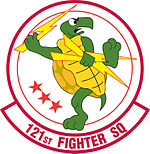121st Fighter Squadron
| 121st Fighter Squadron | |
|---|---|

General Dynamics F-16D Block 30 Fighting Falcon (s/n 85-1509) from the 121st Fighter Squadron
|
|
| Active | 10 April 1941 – present |
| Country | United States |
| Branch | United States Air Force |
| Type | Squadron |
| Role | Fighter |
| Part of | District of Columbia Air National Guard |
| Garrison/HQ | Joint Base Andrews, Camp Springs, Maryland |
| Nickname(s) | Capital Guardians |
| Tail Code | "DC" Red tailstripe w/stars |
| Battle honours |
World War II Operation Southern Watch Operation Northern Watch Operation Iraqi Freedom Operation Enduring Freedom |
| Insignia | |
| 121st Fighter Squadron emblem |  |
The 121st Fighter Squadron (121 FS) is a unit of the District of Columbia Air National Guard 113th Wing located at Joint Base Andrews, Camp Springs, Maryland. The 121st is equipped with the Block 30 F-16C/D Fighting Falcon.
The squadron is a descendant organization of the 121st Observation Squadron, established on 10 July 1940. It is one of the 29 original National Guard Observation Squadrons of the United States Army National Guard formed before World War II.
In the early 1960s, the 121st Tactical Fighter Squadron developed and approved a fuselage insignia, an iron fist and jet fighter superimposed on a national shield. It was thought that the unit had no previous insignia, but the designers were incorrect. A Maryland Terrapin originally flew with the District of Columbia Air National Guard and, many years later, was reinstated as the unit's insignia.
The original design, approved in 1943, and authenticated as correct by the Air Museum, Wright-Patterson Air Force Base, is described as follows.
"A caricatured tan and brown turtle proper , riding a "pogo" stick, leaving a trail of hops and impact marks black, all outlined light turquoise blue. Significance: The turtle depicts slow but sure travel, as characterized by the story of the "Tortoise and the Hare" in "Aesop's Fables." The short hops and limited range of liaison airplanes are depicted by the short hops the turtle is making on the pogo stick."
Established by the National Guard Bureau as the 112th Observation Squadron and allocated to the District of Columbia National Guard in July 1940. Not organized until April 1941, formed in Washington D. C. without aircraft assigned.
Unit was ordered to active duty in April 1941 as part of the buildup of the Army Air Corps after the Fall of France. Assigned to Bolling Field, D.C. and equipped with light observation aircraft. Transferred to Third Air Force in September 1941, began flying coastal anti-submarine flights over the South Carolina coastline from airfields in the Columbia area. Moved to First Air Force at Langley Field, Virginia, again engaging in antisubmarine patrols over the Maryland, Virginia and upper North Carolina coasts and the approaches to Chesapeake Bay. Moved to Birmingham, Alabama in October 1942 and inactivated. Squadron personnel being reassigned to other units and aircraft being transferred to other duties.
...
Wikipedia
